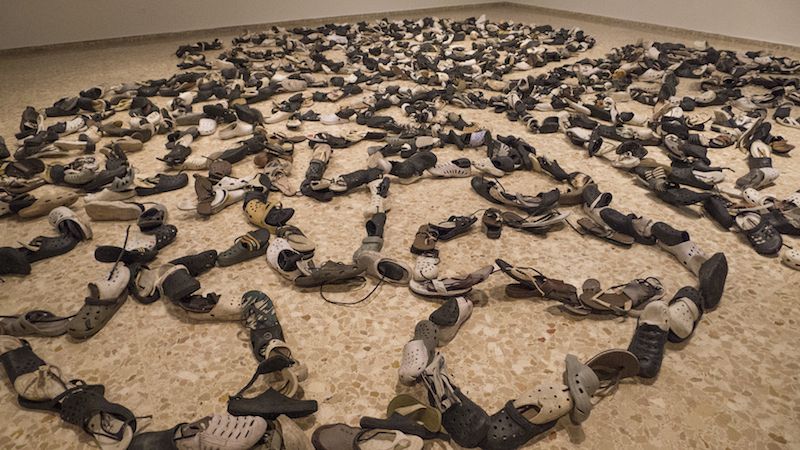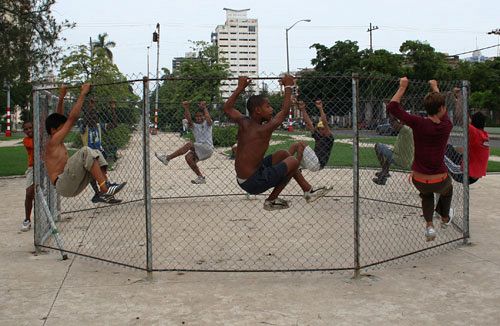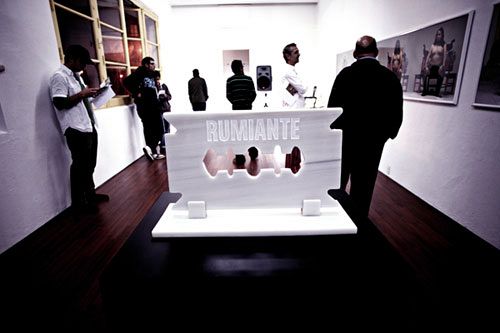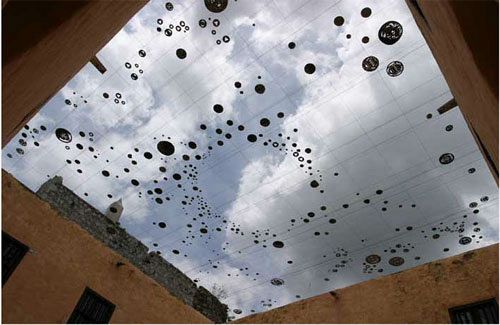Leah Gordon and Andre Eugene, recipients of the 2015 CPPC Travel Award, present a travelogue of their research in the Dominican Republic in September 2015 (Part 1 of 2. Read part 2 here).
Andre Eugene and I were really excited and honored to receive the ICI/Coleccion Patricia Phelps de Cisneros 2015 Travel Award for Central America and the Caribbean. We wanted use this award to explore regional models of artists' self-organisation, alternative strategies of community organisation, research alternative residency projects within the Caribbean region (in relation to our own collaboration, the Ghetto Biennale) and finally to discover new exhibition networks for Haitian artists.
We planned to visit Trinidad and Tobago primarily due to having previous contacts in Port of Spain which could help facilitate the research and the historical linguistic relationship between England and Trinidad. In fact we discovered far more links with Haiti, its history and culture, than we’d expected.
The trip to the Dominican Republic felt timely and important as the precarious situation regarding the legal status of Haitian immigrants, who constitute 5% of the population, was escalating. But also we wanted to explore strategies for creating platforms for cross-cultural exchange between the two countries which are simultaneously intensely proximate and separate.
DOMINICAN REPUBLIC
We arrived on Sunday, September 20th and were staying in the Colonial district. This was convenient for many galleries and art institutions but also close to the Haitian neighbourhood.
On Monday the 21st we had lunch and a studio visit with the Dominican artist Jorge Pineda. Pineda is an artist whose work has been exhibited internationally. He showed work at the 52nd Venice Biennale, and the XXIII Bienal Nacional de Artes Visuales de Santo Domingo, where he won first prize for installation.
We both knew some of his work as myself and Eugene had been in the same group show, Kreyol Factory, which was held in Paris in 2009. We discussed the possible and entangled roots of the current immigration crisis between Haiti and the DR. Jorge spoke about the class, political, and economic issues involved. Jorge listed some of the Haitian artists who have shown their work in the DR, which was a small list including: Edouard Duval-Carrie, Pascale Monnin and Mario Benjamin. We questioned the reason why no Dominican artists had ever applied for the Ghetto Biennale; even though we translate the call into Spanish and distribute it on most Caribbean platforms, it still hasn’t become part of the arts dialogue in the Dominican Republic. We all agreed that this research trip and the consequent networks formed would really provide for further communication and collaboration.

Artist Jorge Pineda.
After a tour of his studio, we focused on discussing some of his works that explored the Haitian and Dominican relationship. He showed us some new work which related to an earlier work, El Paisaje, made in 2007: the work involved stitching together popular paintings from both the Dominican Republic and Haiti to create a giant floor cushion that people could lounge on. These new compilations of appropriated vernacular art were to be incorporated in a performance where Haitian and Dominican women work together, humming a popular song about working in the plantation fields.
In the evening we met with Sara Hermann for an extremely interesting discussion. Sara Hermann works for the Davidoff Initiative and is a consultant at the Centro León of Santiago de los Caballeros in Dominican Republic. She is member of the AICA (International Association of Art Critics) and ICOM (International Council of Museums). She was the director of the Museo de Arte Moderno of Santo Domingo between 2000 and 2004, although she had been working there since 1992 as coordinator of international relations of the institution and manager for its publications. She was part of the curatorial teams for the Caribbean Biennials organized by the Museo de Arte Moderno of Santo Domingo since they started in 1992. Sara Hermann was also on the board of the curatorial team of the 1st Caribbean Triennial in 2010 at the Museo de Arte Moderno of Santo Domingo.

Sara Hermann with Andre Eugene.
Sara gave us a lot of background to the private art institutions in the Dominican Republic focusing on the Davidoff Initiative, funded by a Tobacco company and Centro de Leon, which is also sponsored by a tobacco family museum built by the tobacco wealth of the León Jimenez family. It seems that private finance has been instrumental in developing and supporting the arts in the Dominican Republic. This was in sharp contrast to Trinidad where the oil companies are more reticent to support the arts. Perhaps this is because they know they will be moving on when the petroleum runs out, whereas the tobacco and sugar companies have deep-rooted and long-term investments in the actual land, country, and culture. We also discussed the politics of any state investment in the arts. But finally she conceded that no doubt in comparison to Haiti they do have a developed infrastructure but that still more work needs to be done. We discussed the ideological use of modernism in the Caribbean and the ways in which that has filtered through arts, architecture, and culture. Sara was pointing out how Modernism had become a veneer for dictatorships in both the Dominican Republic and Haiti. We discussed reading the structure of cities as a metaphor for power dynamics. I asked Sara about the balance (or imbalance) between state involvement in the arts, private institutions, and artist-led initiatives. Sara discussed culture as a force for development and also stated quite categorically that she felt very strongly that cross-cultural interaction between Haiti and the Dominican Republic was one of the most positive solutions to the ongoing hostilities between Haiti and the DR. We also discussed that if the Ghetto Biennale was an audacious intervention in respect of class exclusion in the arts then to imagine a ‘Hispaniolan Biennale’ could be a conceptual intervention in the relations between the two countries.
The next day we drove to the east to visit the Davidoff Initiative in Altos de Chavon in La Romana. Then we met Josefina Pichardo, who is the director of the Museum La Altagracia in La Huguey, and finally met some of the Haitian immigrants who produce the art sold to tourists in the beach resort of Punta Cana.
We were shown around the Davidoff Initiative by Martha Victoria. She explained how the foundation has a gallery, school of art and design (which is affiliated with Parsons in New York) and an artists’ residency programme. The residency programme brings international artists who can stay for up to three months and have the space and time to make new work, leading to an exhibition onsite. We saw the art classes, students, and art gallery, which were all very impressive. We were especially impressed to hear that they have a scholarship programme for underprivileged students.

At the Davidoff Initiative.
After that visit we drove on to La Huguey, where we first visited Josefina Pichardo at the Museum La Altagracia. We were given an extremely interesting and informative tour of the museum of sacred arts. We also viewed the newer space, where they curate shows of contemporary art that relate to the themes in the permanent collection. This was a beautiful museum and the new contemporary space was helping to bring a fresh view on the collection and the cathedral itself.

Josefina Pichardo at the Museum La Altagracia.
After that visit we met with Evel, a colleague of Andre Eugene and member of Atis Rezistans. Whilst he lives in Haiti, he has a small business in the Dominican Republic importing the artisaneer made in the Grand Rue neighbourhood and sold in Punta Cana.

Artisaneer from Haiti.
He introduced us to many Haitian artists living as undocumented immigrants in the DR who paint pictures sold as Dominican work. They can be paid as little as $2 per painting which are then sold in the resorts for $60 per painting.

Haitian painter.
When we sat and interviewed the artists, it was interesting that even though they worked almost on an assembly line, all of them had their own personal work which they were eager to show me but felt frustrated that there was no market or interest in their personal work. At this point we became aware there were two parallel art worlds in the DR separated by class and race.

Andre Eugene.

Centro Leon meeting.
The next day we rose early and took a bus to Santiago to meet Luis Felipe Rodríguez, who is the director of the Centro Cultural Eduardo León Jimenes aka Centro Leon. We explored the museum and they explained that a majority of the art collection comes from an open call to Dominican artists that takes place every year. The collection was rich and varied and represented many decades of Dominican art. In addition, there was a more ethnographic section which represented aspects of Dominican culture, history, and lifestyle, using sophisticated display and scenography. It was very interesting to note the disconnect of contemporary Dominican and Haitian art but also see the deep connections between the cultural lives depicted in the ethnographic displays.

Inside the Centro Leon, ethnographic exhibition.
Luis Felipe Rodríguez expressed an interest in visiting the Ghetto Biennale and also perhaps looking toward hosting a joint Haitian and Dominican art show. But at the same time he admitted that there could be possible political complications involved in a joint country art show, as some people in power could feel threatened that this could be a precursor to reunion.

Inside the Centro Leon.
In the evening we returned to Santo Domingo and went to a private view at the Casa Quien Gallery in the Colonial Zone of Santo Domingo, corner of Arzobispo Nouel and Calle Sanchez, which was curated by Raul Miyar. The work was, in the context of issues around gender and sexuality in the DR, quite contentious and risky. We discussed the recent issues at Raw Material in Senegal due to a show of art by homosexual artists.

Artist Carlos de Leon at Casa Quien Gallery.
On Thursday the 24th we revisited the Casa Quien Gallery for a more formal interview with Raul Miyar, who is also a tutor at the Altos de Chavón School of Art and Design, and met one of his former students named Carlos de Leon, who received a scholarship to finish his art degree at Parsons. Raul and Carlos talked about what a great chance this programme and cross-institution collaboration was for the advancement of Dominican art and also for the broadening of class involvement in the arts. Carlos spoke about how his experience at Parsons utterly broke down and expanded his concept of what art is and what it does. When I asked about the balance between the state, the private, and artist-led initiatives, Raul told us about Rossy Ramos who started running artist-led pop-up shows in Santo Domingo.

Raul Miyar with his former student, Carlos.
Next we met with Belkis Ramirez, a female artist who was part of the Dominican collective Quintapata along with Jorge Pineda, Raquel Paiewonsky, Pascle Meccariello and earlier in its existence, Tony Capellán. We met at her flat/cross studio, which was a modest inviting apartment as well as a great showcase for her art.

Artist Belkis Ramirez.
Belkis talked to us about the progression of her practice from a more commercial woodcut practice to a conceptual practice. She spoke about her relationship to art practice as a female artist and also her desire to change practice, form, and process. She also discussed how on one level Quintapata was instrumental to her artistic practice but how it was also important for her to establish her practice individually at some point in her career.
In the evening we met with Jean-Philippe Moiseau, a Haitian artist living in the Dominican Republic with his British wife. To answer our question about which sector is more important to the arts – the private, the government or artist-run groups − Jean-Philippe answered that the private sector was the most important to the health of the promotion and development of fine arts in the DR. He felt that the government states that they do not have enough funds but he believes that the governmental giving to the arts has become politicized too. When considering artist-run groups and spaces, he believes these initiatives can work in countries such as the UK due to state funding but that without funding it is more difficult to achieve in the DR. Jean-Philippe expressed that it was most important to go into the popular neighbourhoods (the slum areas) and give people the means to create, with materials and teachers, as he knows that the desire to create is not the problem but the means. He believes that it is important that art should rise up from the grassroots. I commented that he was the first interviewee that placed any importance on art coming from the popular neighbourhoods. Jean-Philippe mentioned that Haiti has a very rich culture, which can often become demonized, and he thinks that greater cultural parity and collaboration could help overcome this demonization, leading to greater understanding between the two countries that share this island.
We asked about any potential future of cross-cultural exchange between the DR and Haiti. Jean-Philippe responded that cultural exchange was very important and that it was important for these exchanges to have continuity. He said that there were no shortage of such initiatives after the earthquake, but that the energy has dissipated now the trauma is past and it should be kept more constant. Also he feels that the Haitian cultural community should look further than the twelve big names that always take part in these exhibitions: to broaden their curatorial palette and look for newer emerging talents. He feels that cross-cultural artists’ associations would help combat the politicians in whose interests it is for this not to happen. The bi-national eco-touristic fair was specified as a potential regular event within which a cultural aspect could be expanded. Jean-Philippe talked about the Bienal Nacional de Artes Visuales about which we had received many dissenting opinions and positions. Jean-Philippe said there are many doubts as to how the works are chosen and how the prizes are awarded, and says that there are numerous claims of nepotism.
On Friday the 25th we took part in the ICOM (International Council of Museums) conference and were given a marvelous platform to talk out the Ghetto Biennale, the complex layers of institutional critique, and institutional desire apparent in the Ghetto Biennale. The presentation was really well-received and garnered much interest.

Presenting for ICOM Conference.
We visited the Centro de la Imagen, which is a great space, although the exhibition on view was a response to an open call that was lacking any curatorial theme or structure. There was a lack of coherence and aesthetic strength to much of the work shown. We were sadly unable to locate anyone to talk to, but we were both aware that this was a great space to promote photography and thought that Haiti could really benefit from a similar organization and space.

Centro de la Imagen.
We then met with Limber Vilorio at the Gallery ASR on 904 Ave Abraham Lincoln. He discussed his practice and gave us a few more insights into the commercial art system in Santo Domingo. He was now represented by a space that concurrently displays high-end furniture and home decorations with local contemporary art. He explained that this is a system that is becoming more prevalent within the current art world. Whilst he was uncomfortable with the links between commercial decorative economies and his art, he was aware that this brought him more visibility and sales.

Work by Limber Vilorio.
In the afternoon we met with some of Eugene's Haitian friends, who ship artisaneer into the DR from Eugene’s neighbourhood. We also met with a group of Haitian immigrants who work in the informal economy selling sweets, coffee and biscuits from Baks, which are portable makeshift stalls built on top of old children’s pushchairs. We discussed the possibility of me returning to do a film and photography project on the Baks. We saw Haitian paintings selling alongside Dominican paintings in the tourism areas, which paralleled with Jorge Pineda’s project.

Imported paintings from Haiti.
Continue reading Part 2 here.
The research for this project was made possible by the generous support of ICI and Colección Patricia Phelps de Cisneros (CPPC) through the CPPC Travel Award for Central America and the Caribbean.











